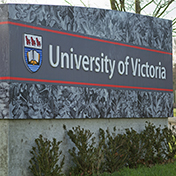A salty solution to energy needs
- Jody Paterson

A UVic engineering graduate's new technology stores energy by mixing salt and fresh water
Separate salt and water, and they long to come back together. That special chemistry could provide an innovative solution to the dilemma of storing and extracting surplus energy generated by intermittent energy sources such as solar, wind and wave power.
Entrepreneur and mechanical engineer Devesh Bharadwaj was still a UVic undergrad when he founded Pani Energy Inc. in March 2017 with a vision of providing clean water and energy to the world through affordable technologies that reduce emissions and costs.
Having discovered a more energy-efficient process to desalinate water for human and industrial consumption, Bharadwaj launched Pani with the support of UVic’s business incubator, Coast Capital Savings Innovation Centre, to market that technology.
Along the way, Bharadwaj got intrigued by the idea of reversing the desalination process as a means of storing energy, taking advantage of the concentration differences between salt and fresh water. That has led to Pani’s newest venture—osmotic energy storage.
Bharadwaj demonstrated that technology this March in Vancouver at the GLOBE Forum, a biennial event bringing together business and governments from all over the world to accelerate the shift to a sustainable, clean economy.
The unpredictability of energy produced by sunshine, wind and waves is a major barrier to countries and regions that don’t have the mountainous terrain suitable for generating hydro-electricity. Intermittent sources provide clean, renewable energy, but can’t be counted on to provide consistent power when it’s needed.
“Take water up a hill and let it fall down, and it spins a turbine that produces electrical energy. The majority of the planet stores its energy this way through what’s known as pumped hydro,” explains Bharadwaj. “But that requires a certain terrain—hills and mountains—to take advantage of gravity.
“In the osmotic energy process, it’s the mixing of the salt and water that spins the turbine. Our method stores energy using a difference in salt concentration, making it unconstrained by geography.”
Similar to the way that a bank of batteries stores energy from solar panels for use on a day without sunshine, Bhardwaj’s technology stores it by using that energy to separate salt from water on sunny days, then mixing the salt back into the water to draw out that stored energy when it’s needed.
The technology is intended for large-scale applications, as the tanks of briny and fresh water require significant space.
Bharadwaj expects the storage cost per kilowatt hour to range from 10 to 60 cents, a significant savings compared to costs of between 70 cents and $1.70 kw/h for storing energy in lead-acid batteries. “Our goal is to be cheap and environmentally benign,” he says.
Funding for Bharadwaj’s work comes from the National Research Council, ECO Canada and private investors.
UVic supports Bharadwaj’s work through the Innovation Centre, as well as through the involvement of Pani Vice President of Research Tom Fyles, a professor emeritus in UVic’s chemistry department; and advisor Henning Struchtrup, a professor in mechanical engineering.
Photos
In this story
Keywords: student life, clean energy, water, sustainability, alumni, mechanical engineering, business, Coast Capital Savings Innovation Centre, climate solutions
People: Devesh Bharadwaj
Publication: The Ring





